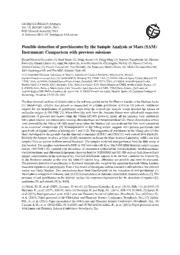
NASA Technical Reports Server (NTRS) 20130009942: Possible Detection of Perchlorates by the Sample Analysis at Mars (SAM) Instrument: Comparison with Previous Missions PDF
Preview NASA Technical Reports Server (NTRS) 20130009942: Possible Detection of Perchlorates by the Sample Analysis at Mars (SAM) Instrument: Comparison with Previous Missions
GeophysicalResearchAbstracts Vol.15,EGU2013-6529,2013 EGUGeneralAssembly2013 ©Author(s)2013.CCAttribution3.0License. Possible detection of perchlorates by the Sample Analysis at Mars (SAM) Instrument: Comparison with previous missions RafaelNavarro-Gonzalez(1),BradSutter(2),DougArcher(3),DougMing(3),JenniferEigenbrode(4),Heather Franz(4),DanielGlavin(4),AmyMcAdam(4),JenniferStern(4),ChristopherMcKay(5),PatriceColl(6), MichelCabane(7),PamelaConrad(4),PaulMahaffy(4),FranciscoMartín-Torres(8),MariaZorzano-Mier(8), JohnGrotzinger(9),andTheMSLScienceTeam(9) (1)UniversidadNacionalAutonomadeMexico,InstitutodeCienciasNucleares,MexicoCity,Mexico ([email protected]),(2)Jacobs-ESCG,Houston,TX77058,USA,(3)NASAJohnsonSpaceCenter,HoustonTX 77058,USA,(4)NASAGoddardSpaceFlightCenter,Greenbelt,MD20771,USA,(5)NASAAmesResearchCenter, MoffettField,CA94035,USA,(6)LISA,Univ.Paris-EstCréteil,Univ.DenisDiderot&CNRS,94000Créteil,France,(7) LATMOS,Univ.PierreetMarieCurie,Univ.VersaillesSaint-Quentin&CNRS,75005Paris,France„(8)Centrode Astrobiología(CSIC-INTA)CarreteradeAjalvirkm.4,28850TorrejóndeArdoz,Madrid,Spain,(9)CaliforniaInstituteof Technology,Pasadena,CA91125,USA ThefirstchemicalanalysisofsolublesaltsinthesoilwascarriedoutbythePhoenixLanderintheMartianArctic [1]. Surprisingly, chlorine was present as magnesium or calcium perchlorate at 0.4 to 0.6 percent. Additional support for the identification of perchlorate came from the evolved gas analysis which detected the release of molecularoxygenat350-550C[1].WhenMars-likesoilsfromtheAtacamaDesertwerespikedwithmagnesium perchlorate (1 precent) and heated using the Viking GC-MS protocol, nearly all the organics were combusted butasmallamountwaschlorinated,formingchloromethaneanddichloromethane[2].Thesechlorohydrocarbons were detected by the Viking GC-MS experiments when the Martian soil was analyzed but they were considered to be terrestrial contaminants [3]. Reinterpretation of the Viking results suggests <0.1 percent perchlorate and ppmlevelsoforganiccarbonatlandingsite1and2[2].ThesuggestionofperchlorateintheVikingsites[2]has beenchallengedonthegroundsthatthedetectedcompounds(CH3ClandCH2Cl2)werecarriedfromEarth[4]. RecentlytheSampleAnalysisatMars(SAM)instrumentonboardtheMarsScienceLaboratory(MSL)ranfour samplesfromanaeolianbedformnamedRocknest.Thesamplesanalyzedwereportionedfromthefifthscoopat thislocation.Thesampleswereheatedto835Cat35C/minwithaHeflow.TheSAMQMSdetectedamajoroxygen release (300-500C) [5], coupled with the release of chlorinated hydrocarbons (chloromethane, dichloromethane, trichloromethane,andchloromethylpropene)detectedbothbySAMQMSandGC-MSderivedfromknownEarth organiccontaminantsintheinstrument[6].CalciumperchlorateappearstobethebestcandidateforevolvedO 2 in the Rocknest samples at this time but other Cl species (e.g., chlorates) are possible and must be evaluated. ThepotentialdetectionofperchloratesinRocknestmaterialaddsweighttotheargumentthatbothVikingLanders measuredsignaturesofperchlorates.Evenifthesourceoftheorganiccarbondetectedisstillunknown,thechlorine source was likely Martian. Two mechanisms have been hypothesized for the formation of soil perchlorate: (1) Atmosphericoxidationofchlorine;and(2)UVphotooxidationofchloridescatalyzedbymineralcatalysts[7].The presence of soil perchlorates in the Martian surface has important implications for the detection of organics [2], carbonates[8]andnitrates[9]bySAM. [1]Hecht,M.H.,etal.(2009),Science,32,64–67;[2]Navarro-González,R.etal.(2010),JGR,115,E12010;[3] Biemann,K.,etal.(1977),JGR82,4641;[4]Biemann,K.andBada,J.L.(2011),JGR116,E12001;[5]Sutter,B. etal(2013),Paperpresentedatthe43thLunarandPlanetaryScienceConference,Woodlands,Tex.;[6]GlavinD., etal.(2013),Paperpresentedatthe43thLunarandPlanetaryScienceConference,Woodlands,Tex.;[7]Archer, P.D.,Jr.,etal.(2013),Paperpresentedatthe43thLunarandPlanetaryScienceConference,Woodlands,Tex.;[8] Cannon,K.M.,etal.(2012)GRL39,L13203;and[9]Navarro-González,R.,etal.(2013),Paperpresentedatthe 43thLunarandPlanetaryScienceConference,Woodlands,Tex.
